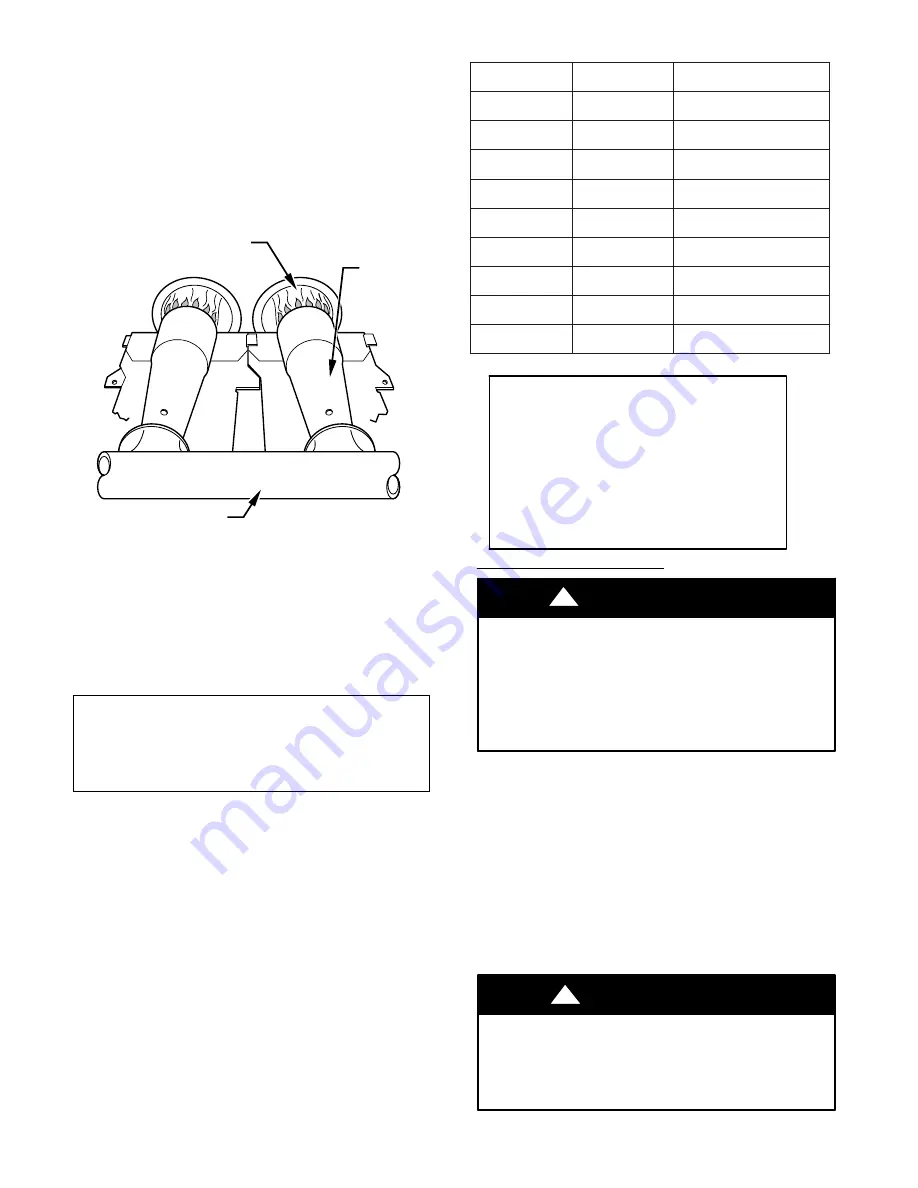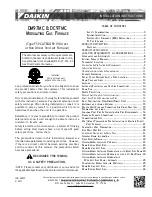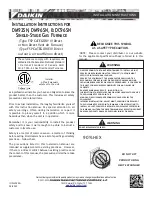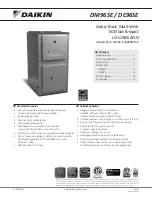
-- 56 --
e. Replace gas valve regulator adjustment screw seal cap.
f. Replace burner enclosure front and verify adjusted gas
input rate using method outlined in Item 3.
g. Look through sight glass in burner enclosure and
check burner flame. Burner flame should be clear blue,
almost transparent. (See Fig. 57.)
h. Remove jumper from R and W.
3. Verify natural gas input rate by clocking gas meter.
NOTE
:
Be sure all pressure tubing, combustion-air and vent
pipes, and burner box cover front are in place when checking
input by clocking gas meter.
;;
;;
BURNER FLAME
BURNER
MANIFOLD
A89020
Fig. 57 -- Burner Flame
a. Calculate high-altitude adjustment (if required)
UNITED STATES
At altitudes above 2000 ft (609.6 M), this furnace has
been approved for a 2 percent derate for each 1000 ft
(304.8 M) above sea level. See Table 14 for derate
multiplier factor.
EXAMPLE:
100,000 Btuh input furnace installed at 4300 ft.
Furnace Input
Rate
X
Derate
Multiplier
=
Furnace Input
Rate at Installation
at Sea Level
Factor
Altitude
100,000
X
0.91
=
91,000
CANADA
At installation altitudes between 2001 to 4500 ft (609.9
to 1371.6 M), this furnace must be derated 5 percent by
an authorized Gas Conversion Station or Dealer. To
determine correct input rate for altitude, see example
above and use 0.95 as derate multiplier factor.
b. Reinstall burner box cover.
c. Gas valve regulator seal cap MUST be on.
d. Turn off all other gas applications and pilots.
e. Start furnace and let operate for 3 minutes.
f. Measure time (in sec) for gas meter to dial to complete
1 revolution.
g. Refer to Table 15 for cu ft of gas per hr.
h. Multiply gas rate (cu ft/hr) X heating value (Btu/cu ft)
using natural gas heating value from local gas
utility/supplier.
Table 14 –
Altitude Derate Multiplier for U.S.A.
ALTITUDE
FT (M)
PERCENT OF
DERATE
DERATE MULTIPLIER
FACTOR*
0–2000
(305---610)
0
1.00
2001–3000
(610---914)
4---6
0.95
3001–4000
(914---1219)
6---8
0.93
4001–5000
(1219---1524)
8---10
0.91
5001–6000
1524---1829)
10---12
0.89
6001–7000
(1829---2134)
12---14
0.87
7001–8000
2134---2438)
14---16
0.85
8001–9000
2438---2743
16---18
0.83
9001–10,000
2743---3048
18---20
0.81
* Derate multiplier factors are based on midpoint altitude for altitude range.
EXAMPLE: (0-2000 ft (0--610 M) altitude)
Furnace input from rating plate is 100,000 Btuh.
Btu heating input = Btu/cu ft X cu ft/hr
Heating value of gas = 975 Btu/cu ft
Time for 1 revolution of 2-cu ft dial = 70 sec
Gas rate = 103 cu ft/hr (from Table 16)
Btu heating input = 103 X 975 = 100,425 Btuh.
In this example, the orifice size and manifold
pressure adjustment is within
±
2 percent of the
furnace input rate.
SET TEMPERATURE RISE
UNIT DAMAGE HAZARD
Failure to follow this caution may result in unit component
damage.
Temperature rise must be within limits specified on furnace
rating plate. Recommended operation is at midpoint of rise
range or slightly above.
CAUTION
!
Determine and adjust air temperature rise as follows:
1. Place thermometers in return and supply ducts as close to
furnace as possible. Be sure thermometers do not see heat
exchangers so that radiant heat does not affect readings.
This
practice
is
particularly
important
with
straight-run ducts.
2. When thermometer readings stabilize, subtract return-air
temperature from supply-air temperature to determine air
temperature rise.
3. Adjust temperature rise by adjusting blower speed.
Increase blower speed to reduce temperature rise.
Decrease blower speed to increase temperature rise.
ELECTRICAL SHOCK HAZARD
Failure to follow this warning could result in personal injury
or death.
Disconnect 115-v electrical power before changing speed tap.
!
WARNING





































